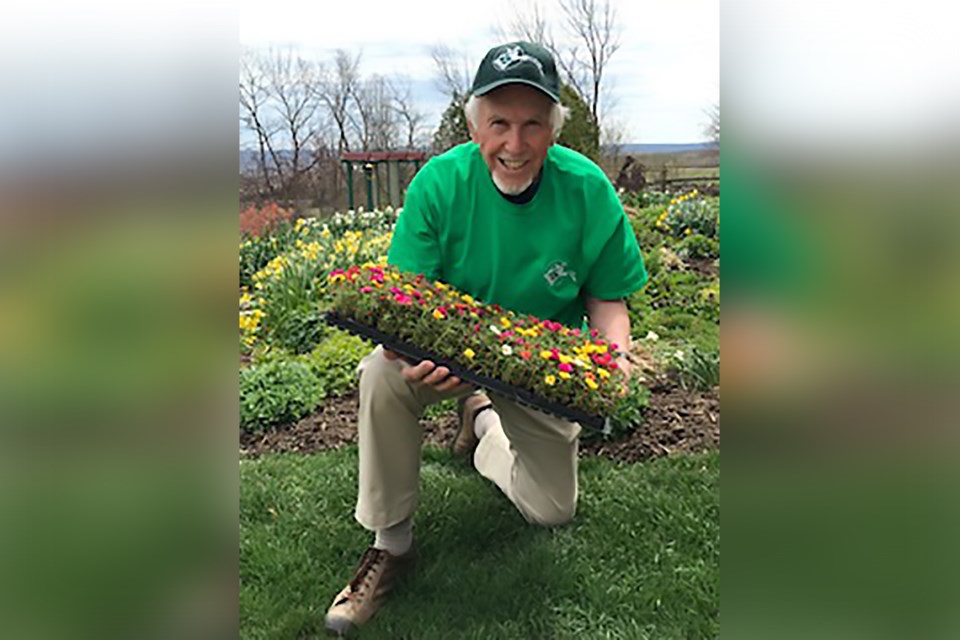John Hethrington has been gardening since the age of 9. He spent his early life gardening in Toronto and earned his certification as a Master Gardener before moving to Meaford where he cultivates 2.5 acres with 20 different gardens. He publishes monthly garden tips for local newsletters and his column appears on MidlandToday.ca.
************************
There are lots of things to do in your garden in May, now that spring is here:
- If not done already, clean up winter debris in the garden as soon as the soil is dry enough to work. Dig in manure or compost around perennials and shrubs and weed well. An extra hour weeding now will save three days later in the summer. Use a line to cut sharp straight edges for your beds. For curved edges, run hot water through a hose to soften it up and lay out a smooth curve. Watch you don’t chop the hose!
- Take coloured pictures of your spring bulbs in the gardens so you will know where there are any gaps and where they are when you plant more bulbs in the fall.
- Plan to plant early-blooming bulbs like snowdrops and crocus in the fall at places close to where you come in and out of the house. You will then be greeted by early signs of spring.
- Add three- to four-inches of mulch to flowerbeds and shrubs to conserve moisture and discourage weeds. Shredded cedar bark is best, but expensive.
- Don’t walk on or roll lawns that are still full of water. It compacts the soil.
- If your lawn is already compacted, rent an aerator and dig plugs out of the lawn. Let the plugs dry and rake them back into the lawn as a top dressing. Add grass seed to bare patches.
- When dry, rake lawns vigorously to remove dead grass and thatch.
- Spread weed-free topsoil on thin patches in your lawn. Apply grass seed, roll and water. Keep seed moist, but don’t flood.
- If you find moss in your lawn, the soil is acidic. Apply dolomite lime before a rain.
- If you have very big or deep pots or planters, put some empty plastic water bottles in the bottom of the pot to take up space the roots will never get to. It makes the planter or pot lighter and easier to move, if needed.
- Prepare containers and pots for planting. Fill with a mixture of compost and potting soil. Add peat moss or ,better still, coconut coir to retain moisture.
- Place pots with culinary herbs close to the kitchen door for easy access.
- Pot up your extra perennials for spring plant sales at least three weeks before the sale. Use your best compost, (not garden soil), in the pots. To be really fancy, add a little bone meal to the pot before you put the plant in. Add plant labels with the name (botanical and/or common), colour, sun exposure, height, bloom time, etc. Water well and keep in the shade.
- The St. George’s Anglican church annual COVID Plant Sale is planned for June 12, at the church in Clarksburg. Starts at 7 a.m. Info at 519-599-3811.
- Harden-off seedlings for at least a week before planting. Google the last frost date for your area and allow at least two weeks more before planting tender transplants such as annuals and tomatoes. This year, probably into early June.
- Plant beans directly into the garden as they quickly germinate and will grow as long as the soil is warm. Maybe mid-May this year.
- Install peony rings before the plants start to grow.
- Monitor for the presence of slugs, cutworms, earwigs and tent caterpillars.
- Control weeds in the lawn by hand pulling. Use nematodes to control grubs, which eat the grass roots leading to brown patches in the lawn in summer.
- Prune roses according to type.
- Deadhead faded tulips and daffodils and other spring bulbs but do not cut or pull the leaves out until they are brown and decayed.
- If you have any fritillaries or Asian lilies (daylilies are beetle free), now is the time to watch for the red lily beetle (adult, larva and eggs). So far, removal by hand is the best and only way to reduce the problem.
